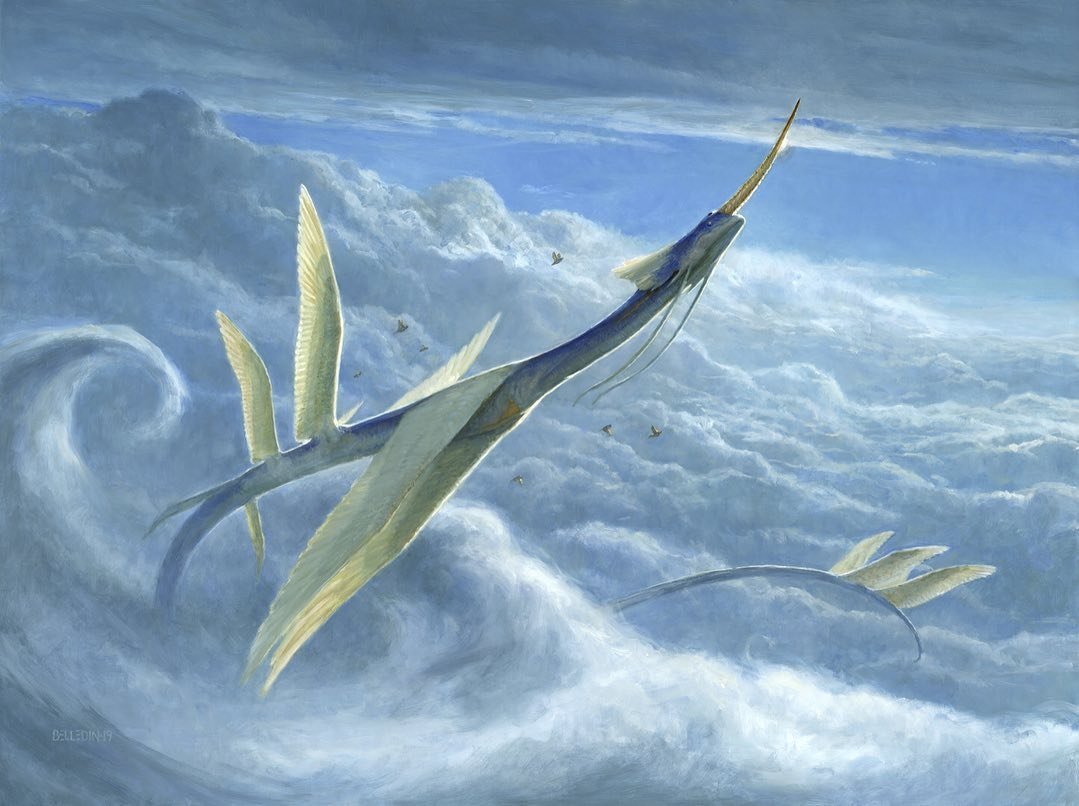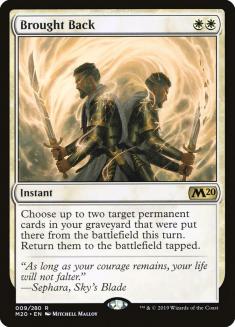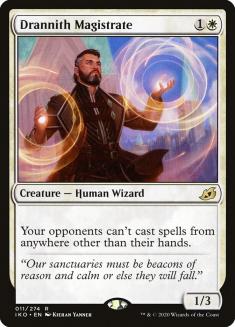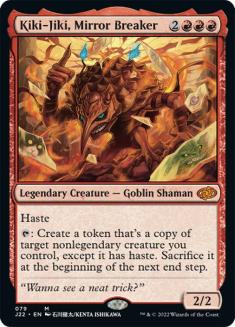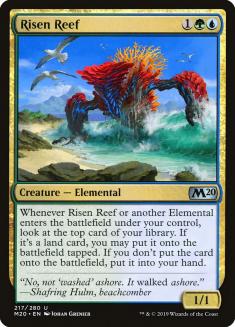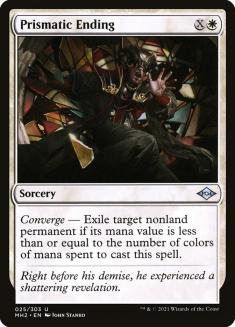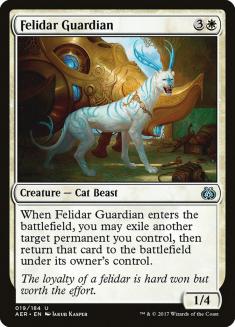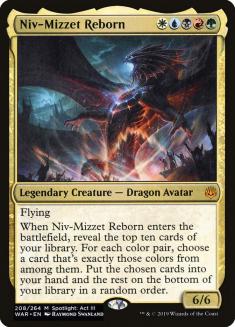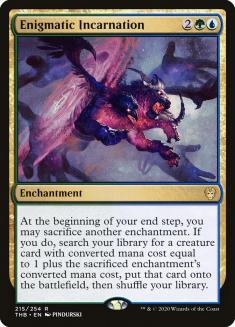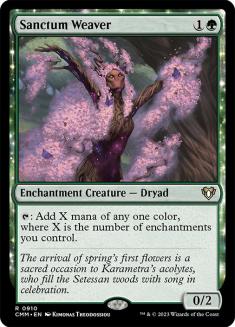As I discussed two weeks ago, I spent a lot of my time at Wizards of the Coast (WotC) testing Modern Horizons 2 playing Yorion decks. The companion rule change hadn’t happened yet at that point, so Yorion was quite a bit more powerful. A lot of other things were different too; for example, Uro, Titan of Nature’s Wrath and Arcum’s Astrolabe were both still legal. Despite the fact that the decks were a little too strong, I had fun playing them. I’m glad to see that a similar kind of deck is succeeding now.
Creatures (29)
- 1 Kiki-Jiki, Mirror Breaker
- 1 Avalanche Riders
- 4 Imperial Recruiter
- 4 Stoneforge Mystic
- 1 Felidar Guardian
- 4 Seasoned Pyromancer
- 1 Giver of Runes
- 2 Charming Prince
- 1 Drannith Magistrate
- 1 Skyclave Apparition
- 1 Glasspool Mimic
- 4 Solitude
- 4 Fury
Lands (31)
Spells (20)

I love this deck played by Dracoon136. I’m most impressed with Brought Back, which can easily return any combination of a fetchland, Mishra’s Bauble, and an evoked Elemental as early as Turn 2, all of which sound excellent. This is a fantastic additional Ephemerate-style card that I haven’t seen other players using.
Drannith Magistrate has become a staple of creature toolbox decks, likely primarily driven by a need to prevent an endless tide of Rhinos from assorted Crashcade decks, but it has some additional utility.
A lot of Yorion decks include a Kiki-Jiki combo kill, which seems fairly important here. This deck doesn’t apply much pressure otherwise. Kiki-Jiki lets it race against people who aren’t interacting much.
I like the clean manabase offered by playing two colors (with a tiny splash for Glasspool Mimic), particularly in a deck that’s trying to use Seasoned Pyromancer and Brought Back.
It’s interesting to see how different decks prioritize different elements, even when they include a lot of similar ideas. This list, for example, has only singletons of Giver of Runes and Skyclave Apparition, while some other players use playsets of both in similar decks. Here, Brought Back encourages a preference for Fury over Skyclave Apparition.
While the clean manabase of this deck offers advantages, I also find the power offered by Omnath, Locus of Creation appealing. That said, I find the idea of relying on Birds of Paradise to make mana work unappealing, because I still expect a lot of Wrenn and Six and Lava Darts, but fortunately, I don’t think that’s necessary.
One of the most appealing aspects of Omnath is that it’s a lot of colors, so you can pitch it to Fury, Endurance, Subtlety, and Solitude, as well as Force of Negation and Force of Vigor.
Once I’m using Omnath to fuel a bunch of Elementals with Ephemerate, I really wonder if Risen Reef is a good card to build around, and if so, how far down that path do I want to go? I’ve considered Elementals decks built around Risen Reef in the past, but Plague Engineer was a huge problem for them. While it’s still strong, Solitude offers a great answer, which makes it far less devastating.
The question is, how much of your deck can be dedicated to doing the Elemental thing, and how much do you need to be building creature decks around a toolbox of bullets to counter opposing strategies?
Creatures (34)
- 2 Eternal Witness
- 2 Mulldrifter
- 1 Reveillark
- 1 Phantasmal Image
- 4 Voice of Resurgence
- 4 Risen Reef
- 1 Omnath, Locus of the Roil
- 1 Healer of the Glade
- 1 Drannith Magistrate
- 4 Omnath, Locus of Creation
- 1 Skyclave Apparition
- 1 Yasharn, Implacable Earth
- 1 Glasspool Mimic
- 4 Subtlety
- 4 Solitude
- 1 Endurance
- 1 Foundation Breaker
Lands (30)
Spells (16)

This is an example of a possible version of this deck that’s very committed to playing up its own Elemental synergies and interacting with the opponent via pitch spells. For the most part, its end-game is nebulously accruing value and then maybe going off with Time Warp every now and again.
I don’t think this is the optimal approach. While Omnath can certainly help win games by attacking with creatures that generated value, without the Kiki-Jiki combo, I think that this deck must allow the opponent to dictate the terms of the game too often, and that it can have trouble meaningfully getting ahead if Risen Reef is killed, which it usually will be. This is the first step in the process.
A common alternative is to try to support the value creatures with planeswalkers. Wrenn and Six and Teferi, Time Raveler are great cards that can join this kind of shell relatively seamlessly.
If I trim most of the cards that are just there to support Elementals, I can make room for more interactive elements. That approach might take me to something like this:
Creatures (22)
- 2 Eternal Witness
- 1 Niv-Mizzet Reborn
- 4 Risen Reef
- 1 Omnath, Locus of the Roil
- 1 Drannith Magistrate
- 4 Omnath, Locus of Creation
- 1 Skyclave Apparition
- 1 Yasharn, Implacable Earth
- 1 Glasspool Mimic
- 4 Solitude
- 1 Endurance
- 1 Fury
Planeswalkers (8)
Lands (30)
Spells (20)

This deck has a lot more interaction, with Prismatic Ending and Lightning Helix as maindeck removal spells in addition to Teferi and Wrenn and Six. Here, Risen Reef is still a meaningful value engine, but we’re not really counting on it surviving.
This deck barely touches black to include a single Niv-Mizzet Reborn, which can only draw up to five cards, and while it won’t be as strong as it is in a deck designed around it, drawing around two spells and getting a Dragon seemed pretty good to me.
While this deck is potentially better able to interact, which can give it more tools to fight opposing strategies, it’s still a very reactive deck that largely allows the opponent to dictate the terms. It just hopes to be better-suited to interacting on those terms.
To address that, we can try to maintain a similar focus on value while incorporating a combo kill:
Creatures (14)
- 1 Wall of Blossoms
- 1 Kiki-Jiki, Mirror Breaker
- 1 Imperial Recruiter
- 4 Felidar Guardian
- 2 Niv-Mizzet Reborn
- 4 Omnath, Locus of Creation
- 1 Valki, God of Lies
Planeswalkers (13)
Lands (30)
Spells (23)

Instead of using Solitude, this deck uses Felidar Guardian. They may not seem interchangeable, but both are misses for Niv-Mizzet that direct the fundamental strategy of the deck. Here, instead of using free spells to convert card advantage into interaction, this deck uses card advantage to try to force through a game-ending combo. It doesn’t disrupt the opponent as well; instead, it tries to make the opponent react to what it’s doing.
Niv-Mizzet Reborn is a much bigger part of this deck because it’s the go-to threat for Bring to Light. Niv-Mizzet is still only expected to draw around two to three cards here, but I think the super-dedicated Niv-Mizzet decks end up with a little overkill anyway.
Hypothetically, if you can force the opponent to answer your threats while you’re generating a lot of card advantage, they should run out of answers, at which point you’ll win. The problem is that your opponent can answer your threats at a mana advantage, so you’ll struggle if they can leverage that tempo into beating you before you can run them out of answers. Veil of Summer and Thoughtseize try to ensure that your threats will actually land to do their job.
If you’re concerned about mana advantage, another direction to take Yorion that I haven’t seen thoroughly explored is to combine it with the Modern Horizons 2 cards that tried to support Enchantress as an archetype. This allows you to use Sanctum Weaver, one of the most explosive mana generators available in Modern, which you can protect with Sterling Grove.
Creatures (20)
- 1 Eternal Witness
- 1 Meddling Mage
- 1 Magus of the Moon
- 1 Scavenging Ooze
- 1 Phantasmal Image
- 1 Renegade Rallier
- 1 Deputy of Detention
- 1 Setessan Champion
- 1 Drannith Magistrate
- 1 Skyclave Apparition
- 1 Glasspool Mimic
- 1 Solitude
- 4 Sanctum Weaver
- 4 Sythis, Harvest's Hand
Planeswalkers (3)
Lands (28)
Spells (29)

This deck uses Enigmatic Incarnation, but it’s less focused on the toolbox elements of Incarnation than its predecessors. Here, we’re using Enigmatic Incarnation primarily to maximize access to Sythis, Harvest’s Hand and Sanctum Weaver, though it can still enable a prison-style end-game.
While I think this is a solid shell for Enchantress, I think it might be missing a more compelling end-game. One option is the Nine Lives + Solemnity combo, but that feels a little narrow. With Sanctum Weaver I wonder if it’s worth including some expensive end-game option like Overwhelming Splendor or even Possibility Storm.
I’m not sure about Resurgent Belief. It seems generically kind of strong, but I’m not sure getting back the cheap enchantments in this deck accomplishes all that much, so that might be the thing to look to replace with some kind of real end-game plan.
Modern’s in an interesting place. it’s starting to take form, and we’re figuring out which cards and archetypes are strong, but the format seems far from solved. There seems to be room for midrange decks, which is encouraging if you’re interested in playing Yorion.

